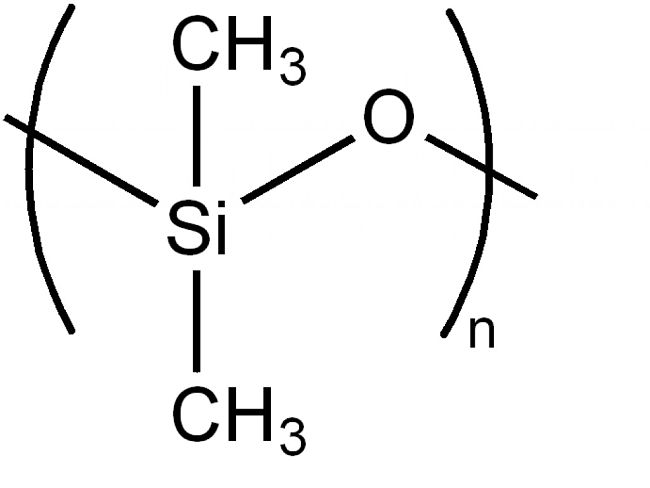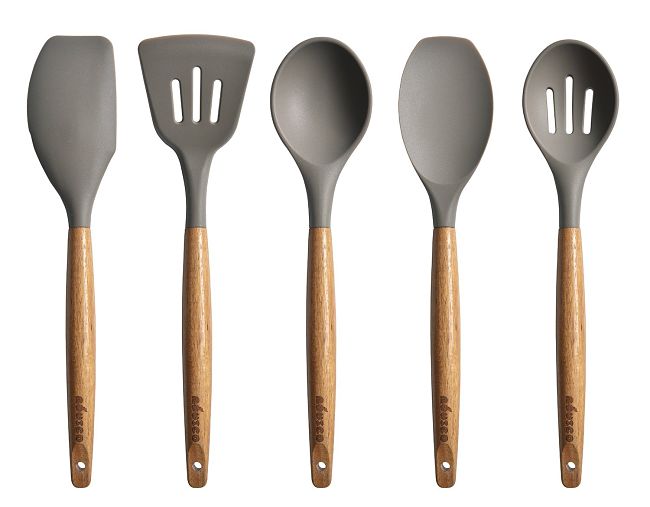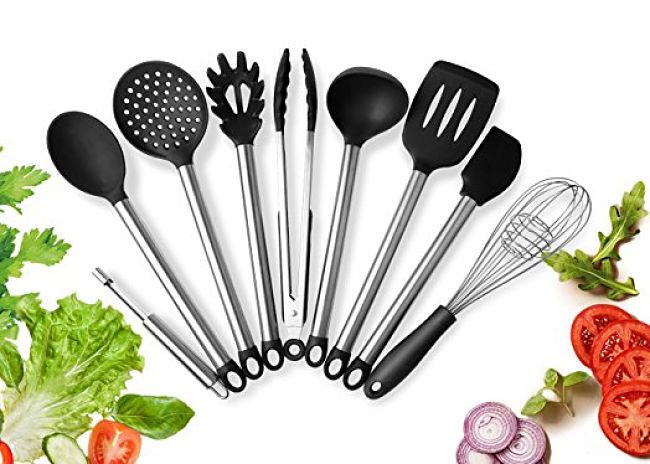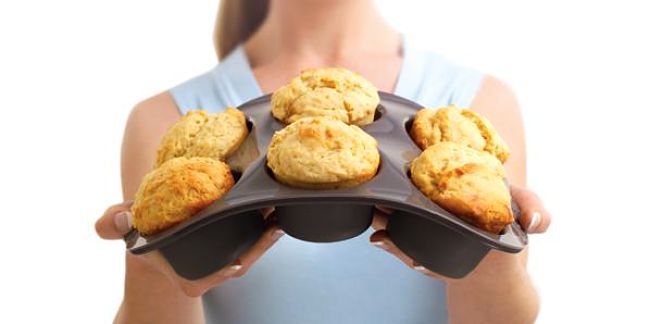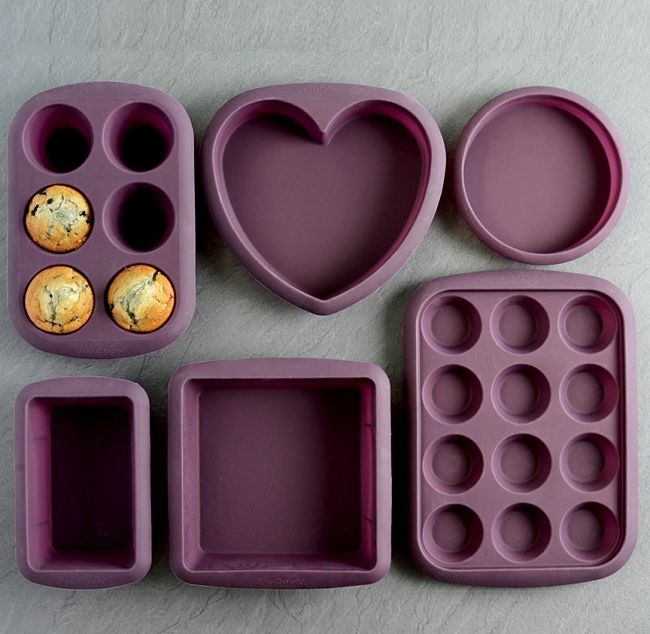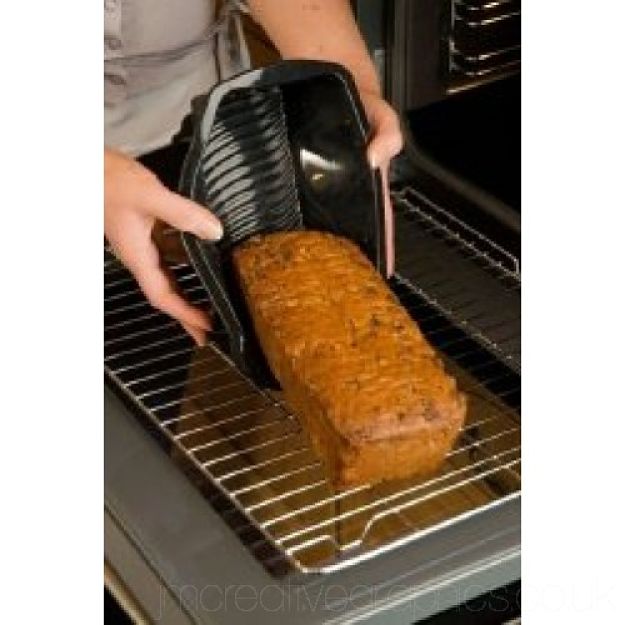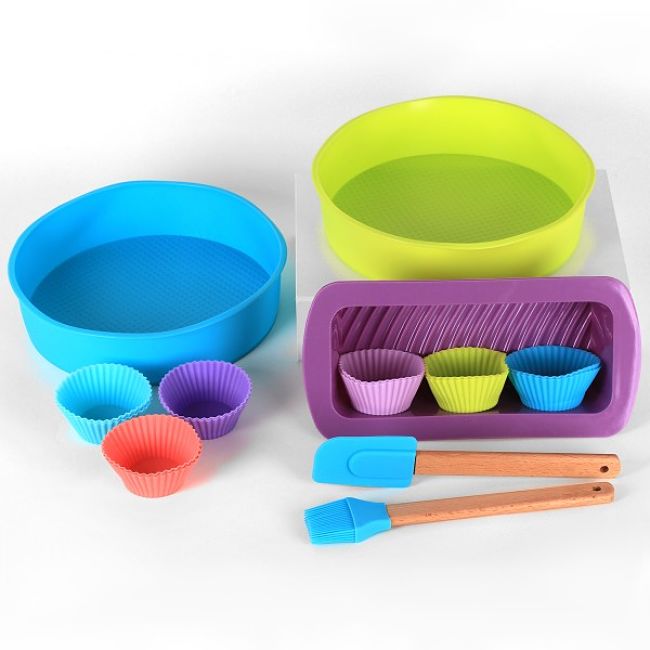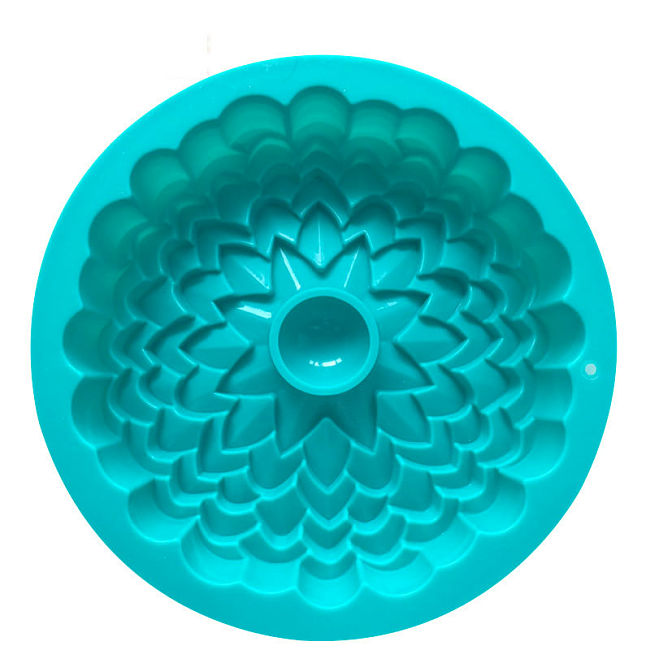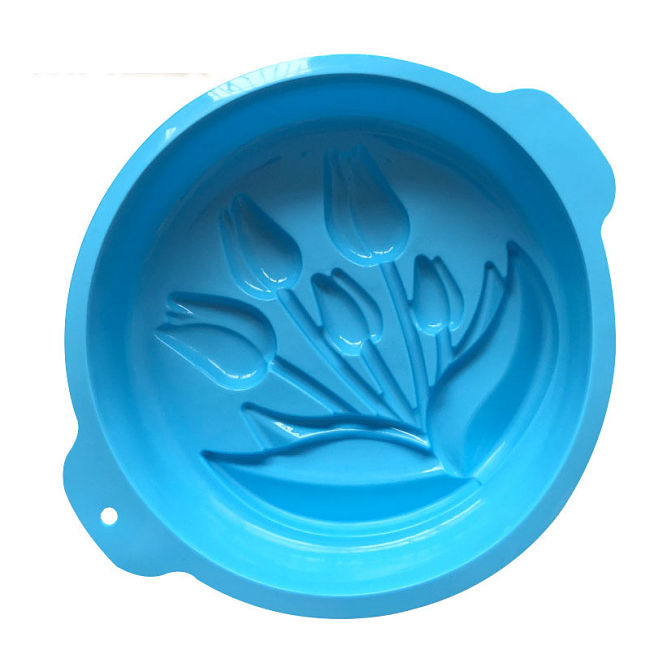Q&A: Silicone Kitchen Utensils, Bakeware – Pros, Cons, Safety Tips, What to Buy
Modern kitchen utensils can be made of rubber, wood, plastics, stain-less steel and other metals with various non-stick coatings. The newest varieties are made of silicone, or are coated with silicone.
There are many baking dishes for cakes, bread, muffins and other items made from flexible silicone. However, despite their good looks, just how safe are silicone utensils and what are their advantages and disadvantages compared to utensils made from other materials.
Are Silicone utensils a good buy? What should you look for when buying them?
How do you use them, clean and look after them? What is the best way to use them?
This article reviews all of these questions in examining the pros and cons of silicone kitchen utensils and provides lots of tips for their use in the kitchen.
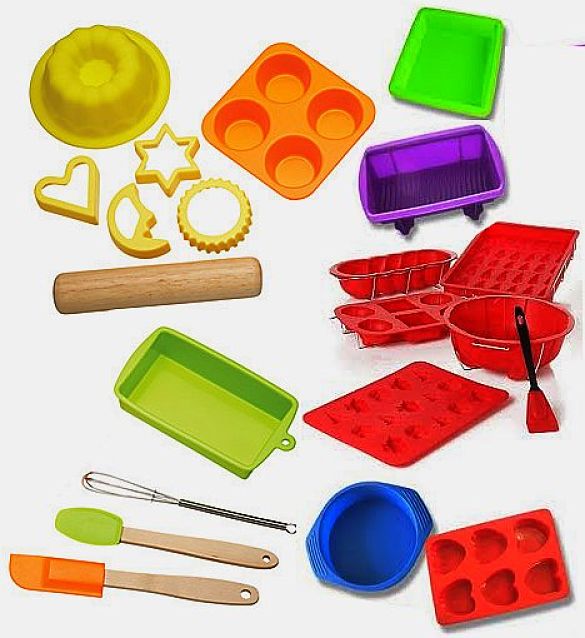
Are Silicone Kitchen Utensils and Bakeware Safe?
There is not a lot of detailed information available on silicone and health. Silicone is a synthetic rubber polymer created by combining silicon with carbon, hydrogen, oxygen, and sometimes traces of other elements. Silicon is a widespread natural element that is very abundant in sand and rock and so we are all exposed to it all the time. You could eat large pieces of silicone without any harm.
Food-grade silicone has been classified as safe by various food standard boards throughout the world. The US Food and Drug Administration (FDA) has approved food-grade silicone for use without qualification for all foods, both for storage and cooking. Some concern has been expressed about chemicals sometimes used as fillers and colors in cheaper grades of silicone bakeware and utensils. It is wise to choose products from reputable brands and to always read the labels. Silicone is not toxic to terrestrial, aquatic or soil organisms or to plants. It is not a hazardous waste when disposed of. It is not biodegradable, however, it can be recycled and can be used for many years and can replace many disposable alternatives.
Silicone is also widely promoted as being as being inert and stable without any taste or odor.It does not cause any tainting odors or affect food quality provided it is not burnt by exceeding the maximum recommended temperature. Check the labels, but the general maximum temperature is about 220 degrees C or 428 degrees F. It is safe for use in microwaves and dishwashers and can be used to store foods in the refrigerator and freezer.
Benefits of Silicone Utensils and Bakeware
A huge variety of silicone products are available for the kitchen. including potholders, spatulas, whisks and many other utensils made of metal with silicone coatings. There are also a huge range of bakeware and storage items such as rolling pins, ice cube trays, cake pans, muffin pans, bread tins, cupcake bakers and many more. The main advantage of silicone goods are that they are flexible and have non-stick surfaces. This makes extracting the cooked cakes and muffins much easier to do. Silicone pans and utensils are very easy to clean as food does not stick to them or baked on remnants are very easy to remove.
Silicone bakeware has been promoted as the environmentally friendly replacement for disposable containers such as cupcake papers and baking paper and are generally much easier to use.
Silicone bakeware It can go directly from the freezer to the oven, and from oven to freezer. Silicone goods are safe in the microwave safe, and are very easy to clean. While silicone bakeware does not generally require rubbing with oil or butter, it is still a good idea to prevent sticking and making the baked goods much easier to remove. Spray oils are a good idea.
One of the big advantages of silicone kitchen utensils is their resistance to damage by heat. Silicone utensils can resist temperatures up to 400 degrees Fahrenheit. So no more burning wooden spoons or other items you happen to leave in the pot or frying pan. The silicone utensils won't usually melt if you accidentally leave them in a pan or pot while cooking.
Silicone utensils are much easier to clean and maintain. They can be safely washed in the dishwasher or hand washed using soapy water and a brush. Silicone kitchen utensils are also very hard to stain and so they always look new with their vibrant colors.
Silicone kitchen utensils do scratch, but it does not matter as it does not make them any harder to keep clean. Some simple precautions are needed to stop scratching your silicon utensils and bakeware. Unlike non-stick coasting, where a few scratches can ruin them, silicone goods are not really affected by scratches.
Disadvantages of Silicone Utensils and Bakeware
While the wonderful flexibility of silicone kitchen utensils and bakeware is often regarded as an asset, it also has disadvantage that many people find hard to get used to. It can be disconcerting if the food or mixture is flopping around especially with hot food. This can be resolved by putting a plate under the pans. For some jobs the utensils may be too flexible, but there are metal ones that are coated with silicone and these are a lot stiffer.
Silicone utensils and pans are also very prone to scratching and you need to look after them. Baked on food remnants may not come off easily in the dish-washer and you may have to remove them by hand.
What To Look for When Buying Silicone Utensils and Bakeware
Ensure the silicone goods you buy made from properly certified food-grade silicone with approval from the Food and Drug Administration (FDA) or similar body. Be careful with some of the cheap imported goods.
Avoid silicone bakeware that has plastic fillers added to the mixture. These fillers are added to reduce the cost, but they are poor quality. Silicone cookware made with additives can crack easily and may have a much reduced less resistance than the certified pure silicone bakeware. Stated maximum temperatures lower than 220 degrees C or 428 degrees F, are sure signs the silicone has fillers added. The fillers can taint the food if heated to high temperature. You can check for fillers by reading the label or doing a bending test. Hold the bakeware and bend it. If you see a series of little white lines appear, the flexible bakeware probably has fillers.
Look for substantial "sturdy" models of silicone utensils, rather than the very thin ones which bend too easily.
Tips for Using Silicone Utensils and Bakeware
Cleaning - Wash your silicone bakeware and utensils in warm soapy water by hand, but don't use any abrasive cleansers and pads to remove remnant. Letting the items soak for a while will dislodge stubborn material. Don't be tempted to scrub the silicone goods with steel wool or any type of metal-bristle brush. This will only scratch the surface. Silicone utensils and bakeware can also be washed in your dishwasher. It pays to remove any large food residues or bake on material first.
Pan Preparation - While traditional bakeware must be greased or line with baking paper silicone pans don't need to be greased, but it is still a good idea to help the baked goods slip out more easily.
Removal of Food from Silicone Pans - To remove cakes allow the silicone baking pan to cool for about 10 minutes. the cake will shrink as it cools. Put a plate or wire wrack on top of the pan and turn over to release the cake. You can flip right-side up using another plate. Loaves of bread and muffins can be removed from the pans while still hot. Hold he silicone pan with a towel protecting your hands and flex the pan gentle to loosen the baked goods from the sides and base. Gently push to indent the underside of the pan to loosen from the bottom. You may need a spatula to help ease the baked goods from the pans.
Safety Tips for Using Silicone Bakeware and Utensils
Silicone bakeware and utensils are generally safe to use. However items which become very scratched should be disposed of as bacteria can be retained in cracks, scratches and cuts. Poor quality goods may have harmful chemicals such as fillers and colors which may leach out into the food.
Oddly the bright colors and ease of cleaning silicone goods may itself be a trap. The items may be put away without being cleaned properly. They may appear to be clean but they are not. It only takes a very thin film to harbor bacteria. Always make sure your silicone bakeware are cleaned thoroughly and dried.
Similarly use of silicone utensils may often be a salmonella risk because people use them on raw chicken before cooking the food, rinse them off and then use the same utensils on the cooked chicken. This can lead to food poisoning. When in doubt plunge the utensils into boiling water to reduce the risk of contamination.
Other Tips for Silicone Utensils and Bakeware
- To remove baked items –release with a silicone spatula – place a plate on top and turn the bakeware upside down. Twist it slightly while gently pressing down on the base. Silicone is very resistant to heat and so items with food in it can go from oven to freezer or from freezer to oven. So you can prepare foods before hand, freeze and place them straight in the oven for cooking.
- Do not slice the cooked items such as cakes and slices in the pans as the knives will slice into the silicone surface. The same applies to cooking utensils that are very easily scratched or cut by knives.
- Silicone Bakeware and Utensils cook down very quickly. However this can be a trap because the contents may be very hot. The wobbly nature of the pans and hot food makes it very easy to spill hot contents onto yourself. So always put a plate under the pan when removing from the oven and use oven mitts when handling the pans
- Silicone bakeware and pans may make the cooking times shorter. So check frequently and make the required adjustments for future baking.
- While silicone is heat resistant it will melt at very high temperatures. Do not be tempted to use silicone bakeware on direct heat sources such as hot plates, grill plates, barbecue racks or stove tops. The same applies to silicone utensils which will melt if they come into contact with hotplates.
- Avoid using steel wool or other abrasive cleaning tools or chemical abrasives as they will damage the surface.
- Place pans removed from the oven onto a cooling tray for ten minutes of so. This will allow the contents to pop out much easier.
Storage Tips for Silicone Bakeware and Utensils
- Always dry the bakeware and utensils well before storing. Residues can harbor bacteria and can taint the food nest time they are used.
- Silicone utensils and bakeware are best washed by hand in a sink filled with warm water with a squirt of mild dish washing liquid soap. Allowing the items to soak for a while will release any baked on residues. One good tip is to use a silicone utensil to remove any residues left on silicone bakeware. This will preserve the surfaces on both items.
- Silicone pans and utensils are not porous, stain resistant and flexible and this makes them very easy to store and maintain
- Silicone bakeware and utensils are safe to wash in the dishwasher, but baked on residues may be hard to remove and may have to be shifted by hand.
- Despite being flexible the bakeware and utensils generally retain their shape well.
